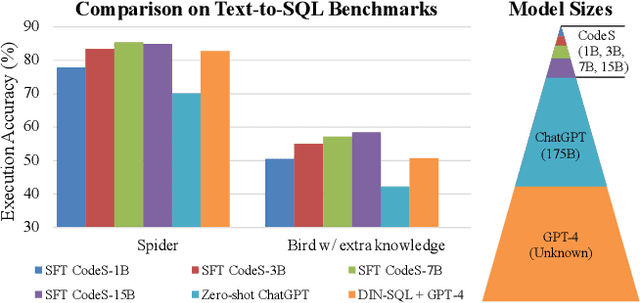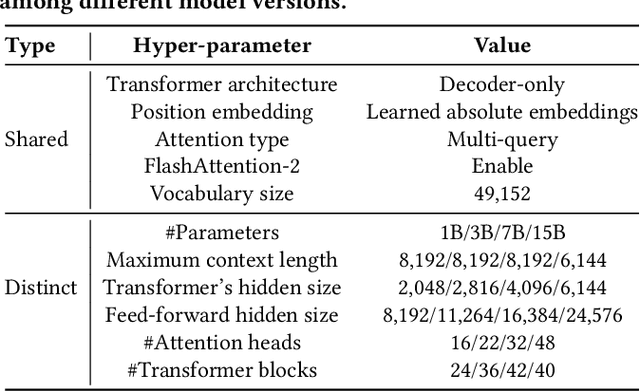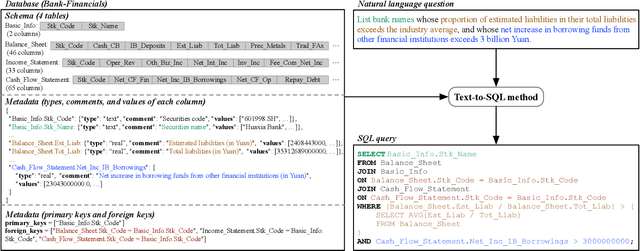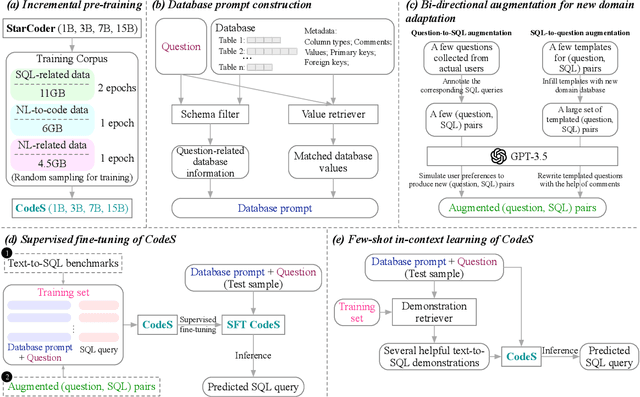Ju Fan
AutoPrep: Natural Language Question-Aware Data Preparation with a Multi-Agent Framework
Dec 10, 2024Abstract:Answering natural language (NL) questions about tables, which is referred to as Tabular Question Answering (TQA), is important because it enables users to extract meaningful insights quickly and efficiently from structured data, bridging the gap between human language and machine-readable formats. Many of these tables originate from web sources or real-world scenarios, necessitating careful data preparation (or data prep for short) to ensure accurate answers. However, unlike traditional data prep, question-aware data prep introduces new requirements, which include tasks such as column augmentation and filtering for given questions, and question-aware value normalization or conversion. Because each of the above tasks is unique, a single model (or agent) may not perform effectively across all scenarios. In this paper, we propose AUTOPREP, a large language model (LLM)-based multi-agent framework that leverages the strengths of multiple agents, each specialized in a certain type of data prep, ensuring more accurate and contextually relevant responses. Given an NL question over a table, AUTOPREP performs data prep through three key components. Planner: Determines a logical plan, outlining a sequence of high-level operations. Programmer: Translates this logical plan into a physical plan by generating the corresponding low-level code. Executor: Iteratively executes and debugs the generated code to ensure correct outcomes. To support this multi-agent framework, we design a novel chain-of-thought reasoning mechanism for high-level operation suggestion, and a tool-augmented method for low-level code generation. Extensive experiments on real-world TQA datasets demonstrate that AUTOPREP can significantly improve the SOTA TQA solutions through question-aware data prep.
Diverse and Fine-Grained Instruction-Following Ability Exploration with Synthetic Data
Jul 04, 2024



Abstract:Instruction-following is particularly crucial for large language models (LLMs) to support diverse user requests. While existing work has made progress in aligning LLMs with human preferences, evaluating their capabilities on instruction following remains a challenge due to complexity and diversity of real-world user instructions. While existing evaluation methods focus on general skills, they suffer from two main shortcomings, i.e., lack of fine-grained task-level evaluation and reliance on singular instruction expression. To address these problems, this paper introduces DINGO, a fine-grained and diverse instruction-following evaluation dataset that has two main advantages: (1) DINGO is based on a manual annotated, fine-grained and multi-level category tree with 130 nodes derived from real-world user requests; (2) DINGO includes diverse instructions, generated by both GPT-4 and human experts. Through extensive experiments, we demonstrate that DINGO can not only provide more challenging and comprehensive evaluation for LLMs, but also provide task-level fine-grained directions to further improve LLMs.
Auto-Formula: Recommend Formulas in Spreadsheets using Contrastive Learning for Table Representations
Apr 19, 2024Abstract:Spreadsheets are widely recognized as the most popular end-user programming tools, which blend the power of formula-based computation, with an intuitive table-based interface. Today, spreadsheets are used by billions of users to manipulate tables, most of whom are neither database experts nor professional programmers. Despite the success of spreadsheets, authoring complex formulas remains challenging, as non-technical users need to look up and understand non-trivial formula syntax. To address this pain point, we leverage the observation that there is often an abundance of similar-looking spreadsheets in the same organization, which not only have similar data, but also share similar computation logic encoded as formulas. We develop an Auto-Formula system that can accurately predict formulas that users want to author in a target spreadsheet cell, by learning and adapting formulas that already exist in similar spreadsheets, using contrastive-learning techniques inspired by "similar-face recognition" from compute vision. Extensive evaluations on over 2K test formulas extracted from real enterprise spreadsheets show the effectiveness of Auto-Formula over alternatives. Our benchmark data is available at https://github.com/microsoft/Auto-Formula to facilitate future research.
CodeS: Towards Building Open-source Language Models for Text-to-SQL
Feb 26, 2024



Abstract:Language models have shown promising performance on the task of translating natural language questions into SQL queries (Text-to-SQL). However, most of the state-of-the-art (SOTA) approaches rely on powerful yet closed-source large language models (LLMs), such as ChatGPT and GPT-4, which may have the limitations of unclear model architectures, data privacy risks, and expensive inference overheads. To address the limitations, we introduce CodeS, a series of pre-trained language models with parameters ranging from 1B to 15B, specifically designed for the text-to-SQL task. CodeS is a fully open-source language model, which achieves superior accuracy with much smaller parameter sizes. This paper studies the research challenges in building CodeS. To enhance the SQL generation abilities of CodeS, we adopt an incremental pre-training approach using a specifically curated SQL-centric corpus. Based on this, we address the challenges of schema linking and rapid domain adaptation through strategic prompt construction and a bi-directional data augmentation technique. We conduct comprehensive evaluations on multiple datasets, including the widely used Spider benchmark, the newly released BIRD benchmark, robustness-diagnostic benchmarks such as Spider-DK, Spider-Syn, Spider-Realistic, and Dr.Spider, as well as two real-world datasets created for financial and academic applications. The experimental results show that our CodeS achieves new SOTA accuracy and robustness on nearly all challenging text-to-SQL benchmarks.
Cost-Effective In-Context Learning for Entity Resolution: A Design Space Exploration
Dec 07, 2023Abstract:Entity resolution (ER) is an important data integration task with a wide spectrum of applications. The state-of-the-art solutions on ER rely on pre-trained language models (PLMs), which require fine-tuning on a lot of labeled matching/non-matching entity pairs. Recently, large languages models (LLMs), such as GPT-4, have shown the ability to perform many tasks without tuning model parameters, which is known as in-context learning (ICL) that facilitates effective learning from a few labeled input context demonstrations. However, existing ICL approaches to ER typically necessitate providing a task description and a set of demonstrations for each entity pair and thus have limitations on the monetary cost of interfacing LLMs. To address the problem, in this paper, we provide a comprehensive study to investigate how to develop a cost-effective batch prompting approach to ER. We introduce a framework BATCHER consisting of demonstration selection and question batching and explore different design choices that support batch prompting for ER. We also devise a covering-based demonstration selection strategy that achieves an effective balance between matching accuracy and monetary cost. We conduct a thorough evaluation to explore the design space and evaluate our proposed strategies. Through extensive experiments, we find that batch prompting is very cost-effective for ER, compared with not only PLM-based methods fine-tuned with extensive labeled data but also LLM-based methods with manually designed prompting. We also provide guidance for selecting appropriate design choices for batch prompting.
SEED: Simple, Efficient, and Effective Data Management via Large Language Models
Oct 01, 2023Abstract:We introduce SEED, an LLM-centric system that allows users to easily create efficient, and effective data management applications. SEED comprises three main components: code generation, model generation, and augmented LLM query to address the challenges that LLM services are computationally and economically expensive and do not always work well on all cases for a given data management task. SEED addresses the expense challenge by localizing LLM computation as much as possible. This includes replacing most of LLM calls with local code, local models, and augmenting LLM queries with batching and data access tools, etc. To ensure effectiveness, SEED features a bunch of optimization techniques to enhance the localized solution and the LLM queries, including automatic code validation, code ensemble, model representatives selection, selective tool usages, etc. Moreover, with SEED users are able to easily construct a data management solution customized to their applications. It allows the users to configure each component and compose an execution pipeline in natural language. SEED then automatically compiles it into an executable program. We showcase the efficiency and effectiveness of SEED using diverse data management tasks such as data imputation, NL2SQL translation, etc., achieving state-of-the-art few-shot performance while significantly reducing the number of required LLM calls.
VerifAI: Verified Generative AI
Jul 06, 2023Abstract:Generative AI has made significant strides, yet concerns about the accuracy and reliability of its outputs continue to grow. Such inaccuracies can have serious consequences such as inaccurate decision-making, the spread of false information, privacy violations, legal liabilities, and more. Although efforts to address these risks are underway, including explainable AI and responsible AI practices such as transparency, privacy protection, bias mitigation, and social and environmental responsibility, misinformation caused by generative AI will remain a significant challenge. We propose that verifying the outputs of generative AI from a data management perspective is an emerging issue for generative AI. This involves analyzing the underlying data from multi-modal data lakes, including text files, tables, and knowledge graphs, and assessing its quality and consistency. By doing so, we can establish a stronger foundation for evaluating the outputs of generative AI models. Such an approach can ensure the correctness of generative AI, promote transparency, and enable decision-making with greater confidence. Our vision is to promote the development of verifiable generative AI and contribute to a more trustworthy and responsible use of AI.
Interleaving Pre-Trained Language Models and Large Language Models for Zero-Shot NL2SQL Generation
Jun 15, 2023Abstract:Zero-shot NL2SQL is crucial in achieving natural language to SQL that is adaptive to new environments (e.g., new databases, new linguistic phenomena or SQL structures) with zero annotated NL2SQL samples from such environments. Existing approaches either fine-tune pre-trained language models (PLMs) based on annotated data or use prompts to guide fixed large language models (LLMs) such as ChatGPT. PLMs can perform well in schema alignment but struggle to achieve complex reasoning, while LLMs is superior in complex reasoning tasks but cannot achieve precise schema alignment. In this paper, we propose a ZeroNL2SQL framework that combines the complementary advantages of PLMs and LLMs for supporting zero-shot NL2SQL. ZeroNL2SQL first uses PLMs to generate an SQL sketch via schema alignment, then uses LLMs to fill the missing information via complex reasoning. Moreover, in order to better align the generated SQL queries with values in the given database instances, we design a predicate calibration method to guide the LLM in completing the SQL sketches based on the database instances and select the optimal SQL query via an execution-based strategy. Comprehensive experiments show that ZeroNL2SQL can achieve the best zero-shot NL2SQL performance on real-world benchmarks. Specifically, ZeroNL2SQL outperforms the state-of-the-art PLM-based methods by 3.2% to 13% and exceeds LLM-based methods by 10% to 20% on execution accuracy.
ChatPipe: Orchestrating Data Preparation Program by Optimizing Human-ChatGPT Interactions
Apr 07, 2023Abstract:Orchestrating a high-quality data preparation program is essential for successful machine learning (ML), but it is known to be time and effort consuming. Despite the impressive capabilities of large language models like ChatGPT in generating programs by interacting with users through natural language prompts, there are still limitations. Specifically, a user must provide specific prompts to iteratively guide ChatGPT in improving data preparation programs, which requires a certain level of expertise in programming, the dataset used and the ML task. Moreover, once a program has been generated, it is non-trivial to revisit a previous version or make changes to the program without starting the process over again. In this paper, we present ChatPipe, a novel system designed to facilitate seamless interaction between users and ChatGPT. ChatPipe provides users with effective recommendation on next data preparation operations, and guides ChatGPT to generate program for the operations. Also, ChatPipe enables users to easily roll back to previous versions of the program, which facilitates more efficient experimentation and testing. We have developed a web application for ChatPipe and prepared several real-world ML tasks from Kaggle. These tasks can showcase the capabilities of ChatPipe and enable VLDB attendees to easily experiment with our novel features to rapidly orchestrate a high-quality data preparation program.
Contextual Expressive Text-to-Speech
Nov 26, 2022Abstract:The goal of expressive Text-to-speech (TTS) is to synthesize natural speech with desired content, prosody, emotion, or timbre, in high expressiveness. Most of previous studies attempt to generate speech from given labels of styles and emotions, which over-simplifies the problem by classifying styles and emotions into a fixed number of pre-defined categories. In this paper, we introduce a new task setting, Contextual TTS (CTTS). The main idea of CTTS is that how a person speaks depends on the particular context she is in, where the context can typically be represented as text. Thus, in the CTTS task, we propose to utilize such context to guide the speech synthesis process instead of relying on explicit labels of styles and emotions. To achieve this task, we construct a synthetic dataset and develop an effective framework. Experiments show that our framework can generate high-quality expressive speech based on the given context both in synthetic datasets and real-world scenarios.
 Add to Chrome
Add to Chrome Add to Firefox
Add to Firefox Add to Edge
Add to Edge